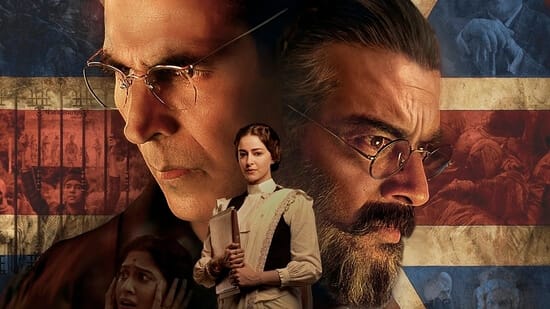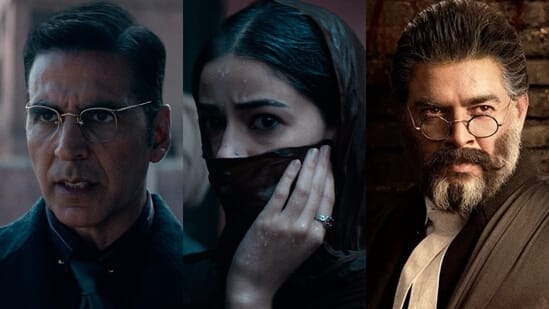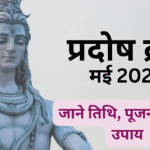Kesari Chapter 2 is more than a film; it serves as a profound cinematic homage to one of India’s most tragic historical events, the 1919 Jallianwala Bagh massacre.
Released on April 18, 2025, the film coincides with the 106th anniversary of this somber event.
Directed by Karan Singh Tyagi and featuring Akshay Kumar, R. Madhavan, and Ananya Panday, the story centers on Justice C. Sankaran Nair’s fight for justice against the British regime.
This courtroom drama merges themes of nationalism, history, and human rights, providing audiences with an engaging and emotional exploration of the past.
Let’s delve deeper into this cinematic experience.

The Historical Background: Reflecting on Jallianwala Bagh
The Jallianwala Bagh massacre stands as a grim episode in colonial India’s narrative.
On April 13, 1919, British Brigadier-General Reginald Dyer commanded his troops to fire on a peaceful crowd in Amritsar, resulting in the deaths of hundreds.
The savagery of this act ignited outrage and marked a critical moment in the Indian independence movement.
Kesari Chapter 2 begins its tale from this national sorrow, focusing on the impact of the incident on the Indian psyche and the brave individuals who confronted the Empire.
The film does not reenact the massacre but instead emphasizes the repercussions—legally, politically, and emotionally—for the Indian populace.
It amplifies the voices of those who pursued justice against a dominating colonial force, offering a fresh and essential viewpoint on a previously chronicled tragedy.
Justice C. Sankaran Nair: The Unsung Hero
Justice C. Sankaran Nair, depicted skillfully by Akshay Kumar, stands out as the protagonist of this narrative.
As a jurist and nationalist, Nair initiated a defamation lawsuit against British authorities for disparaging him when he spoke out about Jallianwala Bagh.
This courtroom clash forms the film’s core.
Unlike conventional patriotic films that heavily feature battlefield heroics, Kesari Chapter 2 honors bravery through intellect, legal proceedings, and moral integrity.
Akshay Kumar’s performance brings depth to this lesser-known character, illustrating him as a principled, witty man with steadfast determination.
Through Sankaran Nair’s perspective, we witness a nation’s conscience awakening, challenging, and affirming itself in the face of injustice.

Performances That Ground the Film
Akshay Kumar delivers a performance imbued with a calm intensity that aligns perfectly with his role as a judge and nationalist.
His portrayal is mature, reserved, and distinctly different from his more commercial roles.
R. Madhavan plays Neville McKinley, a British legal representative, exuding a charming arrogance and strategic reasoning, creating electrifying courtroom confrontations.
Ananya Panday impresses in her role as Dilreet Gill, an ambitious young lawyer and Nair’s aide.
Her character infuses a relatable aspect into the narrative, bridging the divide between youth and heritage.
Each performance enhances the emotional richness of the story, ensuring that the film does not merely recount history but allows the audience to experience it.
Direction and Screenplay: Karan Singh Tyagi’s Insight
Director Karan Singh Tyagi merits recognition for transforming a historical legal battle into a captivating drama.
The screenplay, adapted from ‘The Case That Shook the Empire’ by Raghu Palat and Pushpa Palat, is both concise and intricate.
The pacing captivates viewers, maintaining their engagement despite the courtroom backdrop.
Tyagi effectively employs flashbacks, visuals reminiscent of archival footage, and passionate monologues to keep the narrative dynamic.
He adeptly balances legal complexity with emotional depth, ensuring the film resonates with both intellectuals and mainstream viewers.
The overarching vision reflects a fervor for both filmmaking and justice.
Courtroom Sequences: The True Battleground
The courtroom scenes form the core of Kesari Chapter 2.
In these moments, dialogues serve as the ammunition, and differing ideologies clash like warriors in combat.
The exchanges between Akshay and Madhavan transcend mere verbal conflict, representing ideological battles between the colonizer and the colonized, the oppressor and the resister.
The dialogues are sharp, resonant, and often infused with wit or deep emotion.
Legal jargon is presented clearly enough for viewers to grasp, yet it retains its complexity.
These segments are where the film truly excels, transforming the courtroom into a verbal arena of logic, words, and nationalism.
It is during these scenes that the film powerfully echoes the long-standing calls for justice that once resonated throughout India.
Cinematography and Production Design
The film’s visual aesthetic is serious, respectful, and fitting for the historical period.
From the wooden court benches to the colonial-style buildings of British officials, every aspect is painstakingly recreated.
Debojeet Roy’s cinematography captures the weight of the subject, employing muted colors and intimate close-ups to heighten emotional impact.
Lighting cleverly highlights the balance of power—illuminated for the British, cloaked in shadows for the oppressed, until the power dynamics shift.
Credit also goes to the costume design, particularly in how it embodies both the period and the personalities of the characters.
These visual components unite to immerse viewers in the tumult of 1919.
Music and Background Score: Subtle Yet Moving
In contrast to mainstream films, Kesari Chapter 2 does not depend on a heavily laden soundtrack.
The background score, crafted by shashwat sachdev, unobtrusively enhances the serious nature of the courtroom narrative.
Traditional instruments and somber melodies are utilized to evoke feelings of nationalism, grief, and hope.
A particularly memorable moment features a chilling score during a court testimony recounting the massacre’s atrocities—it evokes deep emotion without a single word being sung.
Composer: Sangtar
Lyrics: Sukhwinder Amrit
Vocals: Manmohan Waris, Kamal Heer, Sangtar
Rearranged by: Shashwat Sachdev
- Kithe Gaya Tu Saiyaan (Film Song – Kesari Chapter 2)
Composer: Shashwat Sachdev
Lyrics: Manoj Tapadia
Vocals: Harshdeep Kaur, Arijit Singh
Music Arrangement: Shashwat Sachdev
Release Date: 14 April 2025
The film concludes with a poignant anthem performed by Shreya Ghoshal, beautifully encapsulating the film’s emotional journey.
The music enriches the experience without overshadowing the gravity of the topic.
Reception and Reviews: Critics Weigh In
Initial reviews of Kesari Chapter 2 have been predominantly positive.
Critics have commended the film for its sophisticated approach to patriotism, strong acting performances, and intelligent narrative structure.
Akshay Kumar’s restrained portrayal has been acknowledged as one of his finest works.
Madhavan’s role as the antagonist has also garnered acclaim for its intricate and nuanced interpretation.
However, some reviewers felt that a few moments were excessively dramatic, and that the film’s length could have been more concise.
Nonetheless, the general agreement is that the film successfully educates and emotionally resonates with its audience, functioning as both entertainment and a historical exploration.

Social Relevance and Educational Value
Beyond its cinematic offering, Kesari Chapter 2 stands as a testament to the strength of resistance through writing and legal avenues.
In a time when patriotism is frequently simplified to mere slogans, this film reinstates its profound significance—justice, dignity, and truth.
It encourages younger viewers to discover unsung heroes like Justice Nair and comprehend how legal frameworks can challenge authority.
Educational institutions and history enthusiasts will find great merit in this filmic retelling.
Additionally, it sparks conversations about how the remnants of colonialism continue to influence contemporary democracies.
Ultimately, the film motivates audiences to pursue justice not only for the past but also for the present and future.
Conclusion: An Inspiring Film That Deserves Your Attention
Kesari Chapter 2 is a compelling mix of history, legal issues, and cinematic art.
By examining the repercussions of the Jallianwala Bagh massacre rather than the event itself, the film highlights the quiet legal struggles that contributed to India’s journey to independence.
It narrates the tale of an overlooked hero who opted for intellect over weaponry and law over aggression.
With outstanding performances, intense courtroom scenes, and profound emotional resonance, this film serves as both a significant historical record and a touching work of art.
It is essential viewing for anyone who holds justice, truth, and India’s quest for freedom in high regard.
Also check: Jaat (2025) review









